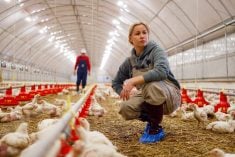Canada’s newest beef packing plant hopes to start processing cattle next spring.
Harmony Beef, located north of Calgary, plans to start taking feedlot cattle for the first six months of operation to test the new systems installed. The plant was purchased by Rich Vesta and his family last year and has been under renovation ever since.
The 75,000 sq. foot plant is the former Rancher’s Beef, built by a group of beef producers in response to the BSE crisis when live cattle were not eligible for export. It only operated for 14 months and closed in 2005.
Read Also

How we’re tracking avian flu’s toll on wildlife across North America
Avian influenza is a virus that is clearly a threat to livestock and human health. Our team, a collaboration of governments and academics across the country, recently assessed the extent of HPAI A(H5Nx) in at-risk species across Canada.
Vesta’s decision to purchase the mothballed plant was under consideration since 2011 after he retired from JBS.
Once it is fully operational, it should handle up to 800 head per day. It will be the largest European Union-approved facility in Canada, meeting exacting food safety and animal welfare standards, said Vesta at the annual Canfax forum held in Calgary Nov. 18.
The decision to maintain EU certification was serendipitous because of the signing of the Comprehensive Economic and Trade Agreement with Europe earlier this year.
Vesta has promised the plant will do things differently than the large multinational companies and will focus on customers in Canada, Europe and Asia. As a smaller facility, it should be able to customize orders and offer beef cuts to meet more exacting specifications.
“We are not big enough to be a major factor in this market. We never wanted to be. We saw the need to do things a little bit differently,” he said.
As the average carcass weight approaches 900 pounds, the result is oversized steaks. The company will handle those larger cattle, but Vesta’s lifelong experience in the meat trade has shown consumers actually want smaller cuts.
“It does no good for a consumer to get a 12 ounce steak that is 3/8 of an inch thick,” he said.
“Every grilling steak should be an inch thick.”
Large steaks that are flat and wide cannot be cooked properly. Oversized rib eyes are not improved by cutting them in half because the muscle quality changes across the dimensions of the cut.
Early on in his career managing facilities for meat packing giants like JBS, Vesta learned the customers were always right and many were willing to pay extra when their specifications were met.
“There are segments out there that want something a little different and they are willing to pay for it,” he said.















